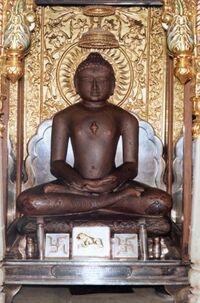Religion:Tirthankara
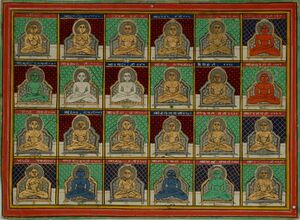

In Jainism, a Tirthankara (Sanskrit: tīrthaṅkara; English: literally a 'ford-maker') is a saviour and supreme spiritual teacher of the dharma (righteous path).[1] The word tirthankara signifies the founder of a tirtha,[2] which is a fordable passage across the sea of interminable births and deaths, the saṃsāra. According to Jains, tirthankaras are the supreme preachers of dharma, who have conquered the saṃsāra, the cycle of death and rebirth, on their own, and made a path for others to follow.[3] After understanding the true nature of the self or soul, the Tīrthaṅkara attains kevala jnana (omniscience). A Tirthankara provides a bridge for others to follow the new teacher from saṃsāra to moksha (liberation).[4]
In Jain cosmology, the wheel of time is divided into two halves, Utsarpiṇī or the ascending time cycle, and avasarpiṇī, the descending time cycle (said to be current now). In each half of the cosmic time cycle, exactly twenty-four tirthankaras grace this part of the universe. There have been an infinite number of tirthankaras in the past periods.[5] The first tirthankara in this present time cycle (Hunda Avsarpini) was Rishabhanatha, who is credited for formulating and organising humans to live in a society harmoniously. The 24th and last tirthankara of the present half-cycle was Mahavira (599 BC–527 BC).[6][7][8] History records the existence of Mahavira and his predecessor, Parshvanatha, the twenty-third tirthankara.[9]
A tirthankara organises the sangha, a fourfold order of male and female monastics, srāvakas (male followers) and śrāvikās (female followers).[10]
The tirthankara's teachings form the basis for the Jain canons. The inner knowledge of tirthankara is believed to be perfect and identical in every respect and their teachings do not contradict one another. The degree of elaboration varies according to the spiritual advancement and purity of the society during their period of leadership. The higher the spiritual advancement and purity of mind of the society, the lower the elaboration required.
While tirthankaras are documented and revered by Jains, their grace is said to be available to all living beings, regardless of religious orientation.[11]
Tīrthaṅkaras are arihants who after attaining kevala jñāna (pure infinite knowledge)[12] preach the true dharma. An Arihant also called Jina (victor), that one who has conquered inner enemies such as anger, attachment, pride, and greed.[4] They dwell exclusively within the realm of their soul and are entirely free of kashayas, inner passions, and personal desires. As a result of this, unlimited siddhis, or spiritual powers, are readily available to them – which they use exclusively for the spiritual elevation of living beings. Through darśana, divine vision, and deshna, divine speech, they help others in attaining kevalajñana, and moksha (final liberation) to anyone seeking it sincerely.
Meaning
The word tirthankara signifies the founder of a tirtha which means a fordable passage across the sea of interminable births and deaths (called saṃsāra).[13][14][15][16] Tirthankaras are variously called "Teaching Gods", "Ford-Makers", "Crossing Makers" and "Makers of the River-Crossing.[17][16]
Tīrthaṅkara-naam-karma

Jain texts propound that a special type of karma, the tīrthaṅkara nama-karma, raises a soul to the supreme status of a Tīrthaṅkara. Tattvartha Sutra, a major Jain text, lists sixteen observances that lead to the bandha (bondage) of this karma:[18]
- Purity of right faith
- Reverence
- Observance of vows and supplementary vows without transgressions
- Ceaseless pursuit of knowledge
- Perpetual fear of the cycle of existence
- Giving gifts (charity)
- Practising austerities according to one's capacity
- Removal of obstacles that threaten the equanimity of ascetics
- Serving the meritorious by warding off evil or suffering
- Devotion to omniscient lords, chief preceptors, preceptors, and the scriptures
- Practice of the six essential daily duties
- Propagation of the teachings of the omniscient
- Fervent affection for one's brethren following the same path.
Panch Kalyanaka

- Five auspicious events called Pañca kalyāṇaka mark the life of every tirthankara:[19]
- Gārbha kalyāṇaka (conception): When ātman (soul) of a tirthankara comes into his mother's womb.[20]
- Janma kalyāṇaka (birth): Birth of a tirthankara. Indra performs a ceremonial bath on tirthankara on Mount Meru.[21][22]
- Tapa kalyāṇaka (renunciation): When a tirthankara renounces all worldly possessions and become an ascetic.
- Jñāna kalyāṇaka: The event when a tirthankara attains kevalajñāna (infinite knowledge). A samavasarana (divine preaching hall) is erected from where he delivers sermons and restores sangha after that.
- Nirvāṇa kalyāṇaka (liberation): When a tirthankara leaves his mortal body, it is known as nirvana. It is followed by the final liberation, moksha, after which his soul dwells in Siddhashila.
Samavasarana
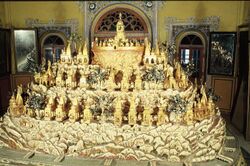
After attaining kevalajñāna, a tirthankara preaches the path to liberation in the samavasarana. According to Jain texts, the heavenly pavilion is erected by devas (heavenly beings) where devas, humans, and animals assemble to hear the tirthankara.[23] A tirthankara's speech is heard by all humans and animals in their language. It is believed that during this speech, there is no unhappiness for miles around the site.[24]
Tīrthaṅkaras of the present cosmic age
Jainism postulates that time has no beginning or end. It moves like the wheel of a cart. The wheel of time is divided into two halves, Utsarpiṇī (ascending half cycle) and Avasarpiṇī (descending half cycle). 24 tirthankaras are born in each half of this cycle. In Jain tradition, the tirthankaras were royal in their final lives, and Jain texts record details of their previous lives. Their clan and families are also among those recorded in legendary stories. Jain canons state that Rishabhanatha, the first tirthankara,[13] founded the Ikshvaku dynasty,[25] from which 21 other tirthankaras also rose over time. Two tirthankaras – Munisuvrata, the 20th, and Neminatha, the 22nd – belonged to the Harivamsa dynasty.[26]
In Jain tradition, the 20 tirthankaras attained moksha on Mount Shikharji, in the present Indian state of Jharkhand.[27] Rishabhanatha attained nirvana on Mount Ashtāpada (Mount Kailash), Vasupujya in Champapuri, Bihar, Neminatha on Mount Girnar, Gujarat, and Mahavira, the last tirthankara, at Pawapuri, near modern Patna. Twenty-one of the tirthankaras are said to have attained moksha in the kayotsarga (standing meditation posture), while Rishabhanatha, Neminatha, and Mahavira are said to have attained moksha in the Padmasana (lotus position).[17]
List
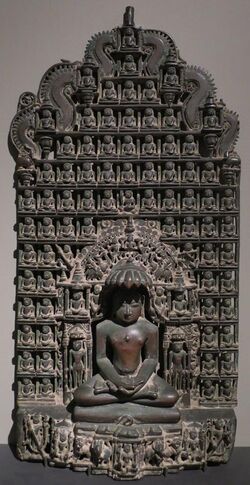
Present cosmic age
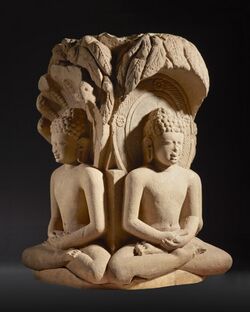
In chronological order, the names, emblems and colours of the 24 tirthankaras of this age are mentioned below:[28][1][29][30]
| No. | Name | Emblem | Colour |
|---|---|---|---|
| 1 | Rishabhanatha[31] (Adinatha) | Bull | Golden |
| 2 | Ajitanatha[31] | Elephant | Golden |
| 3 | Sambhavanatha[31] | Horse | Golden |
| 4 | Abhinandananatha[31] | Monkey | Golden |
| 5 | Sumatinatha[31] | Flamingo | Golden |
| 6 | Padmaprabha[31] | Padma | Red |
| 7 | Suparshvanatha[31] | Swastika | Green |
| 8 | Chandraprabha[31] | Crescent Moon | White |
| 9 | Pushpadanta (Suvidhinath)[31] | Crocodile or Makara | White |
| 10 | Shitalanatha[31] | Kalpavriksha | Golden |
| 11 | Shreyanasanatha[31] | Rhinoceros | Golden |
| 12 | Vasupujya[31] | Buffalo | Red |
| 13 | Vimalanatha[31] | Boar | Golden |
| 14 | Anantanatha[31] | Porcupine according to the Digambara Falcon according to the Śvētāmbara |
Golden |
| 15 | Dharmanatha[31] | Vajra | Golden |
| 16 | Shantinatha[31] | Antelope or deer | Golden |
| 17 | Kunthunatha[31] | Goat | Golden |
| 18 | Aranatha[31] | Nandavarta or fish | Golden |
| 19 | Māllīnātha[31] | Kalasha | Blue |
| 20 | Munisuvrata[31] | Tortoise | Black/Dark Blue |
| 21 | Naminatha[31] | Blue lotus | Golden |
| 22 | Neminatha[31] | Shankha | Black/Dark Blue |
| 23 | Parshvanatha[31] | Snake | Green |
| 24 | Mahavira[31] | Lion | Golden |
Next cosmic age
The 24 tirthankaras of the present age (avasarpinī) are the ones listed above. The names of the next 24, which will be born in utsarpinī age are as follows.
| No. | Name | Previous human birth |
|---|---|---|
| 1 | Padmanabha | King Shrenika[32] |
| 2 | Surdev | Mahavira's uncle Suparshva |
| 3 | Suparshva | King Kaunik's son king Udayin |
| 4 | Svamprabh | The ascetic Potti |
| 5 | Sarvanubhuti | Śrāvaka Dridhayadha |
| 6 | Devshruti | Kartik's Shreshti |
| 7 | Udaynath | Shravak Shamkha |
| 8 | Pedhalputra | Shravak Ananda |
| 9 | Pottil | Shravak Sunand |
| 10 | Shatak | Sharavak Shatak |
| 11 | Suvrat | Satyaki of Mahabharata |
| 12 | Amam | Krishna |
| 13 | Shrinishkashay | Satyaki Rudhra |
| 14 | Nishpulak | Krishna's brother Balbhadra also known as Balrama |
| 15 | Nirmam | Shravika Sulsa |
| 16 | Chitragupta | Krishna's brother's mother Rohini Devi |
| 17 | Samadhinath | Revati Gathapatni |
| 18 | Samvarnath | Sharavak Shattilak |
| 19 | Yashodhar | Rishi Dwipayan |
| 20 | Vijay | Karna of Mahabharata |
| 21 | Malladev | Nirgranthaputra or Mallanarada |
| 22 | Devachandra | Shravak Ambadh |
| 23 | Anantvirya | Shravak Amar |
| 24 | Bhadrakat | Swati |
Iconography
A tīrthaṅkara is represented either seated in the lotus position (Padmasana) or standing in the meditation Khadgasana (Kayotsarga) posture.[33][34] This latter, which is similar to the military standing at attention is a difficult posture to hold for a long period and is preferred by Jains because it reduces to the minimum the amount of the body in contact with the earth, and so posing a risk to the sentient creatures living in or on it. If seated, they are usually depicted seated with their legs crossed in front, the toes of one foot resting close upon the knee of the other, and the right hand lying over the left in the lap.[1]
Tirthankara images do not have distinctive facial features, clothing, or (mostly) hairstyles, and are differentiated based on the symbol or emblem (Lanchhana) belonging to each tirthanakara except Parshvanatha. Statues of Parshvanath have a snake crown on the head. The first Tirthankara Rishabha can be identified by the locks of hair falling on his shoulders. Sometimes Suparshvanath is shown with a small snake-hood. The symbols are marked in the centre or the corner of the pedestal of the statue. The sects of Jainism Digambara and Svetambara have different depictions of idols. Digambara images are naked without any ornamentation, whereas Svetambara ones are clothed and decorated with temporary ornaments.[35] The images are often marked with Srivatsa on the chest and Tilaka on the forehead.[36] Srivatsa is one of the ashtamangala (auspicious symbols), which sometimes resembles fleur-de-lis, an endless knot, a flower, or a diamond-shaped symbol.[37]
The bodies of tirthankara statues are exceptionally consistent throughout the over 2,000 years of the historical record. The bodies are rather slight, with very wide shoulders and a narrow waist. Even more, than is usual in Indian sculpture, the depiction takes relatively little interest in the accurate depiction of the underlying musculature and bones but is interested in the modeling of the outer surfaces as broad swelling forms. The ears are extremely elongated, alluding to the heavy earrings the figures wore in their early lives before they took the path to enlightenment, when most were wealthy, if not royal.
Sculptures with four tirthanakaras, or their heads, facing in four directions, are not uncommon in early sculpture, but unlike the comparable Hindu images, these represent four different tirthanakaras, not four aspects of the same deity. Multiple extra arms are avoided in tirthanakara images, though their attendants or guardians may have them.[38]
In other religions
The first Tirthankara, Rishabhanatha is mentioned in Hindu texts like the Rigveda,[39] Vishnupurana and Bhagwata Purana.[40] The Yajurveda mentions the name of three Tīrthaṅkaras – Ṛiṣhabha, Ajitnātha and Ariṣṭanemi.[41] The Bhāgavata Purāṇa includes legends about the Tirthankaras of Jainism particularly Rishabha.[42] Yoga Vasishta, Chapter 15 of Vairagya Khanda, Sloka 8 gives the saying of Rama:
I am not Rama. I have no desire for material things. Like Jina I want to establish peace within myself.[43]
Champat Rai Jain, a 20th-century Jain writer, claimed that the "Four and Twenty Elders" mentioned in the Book of Revelation (the final book of the Christian Bible) are "Twenty-four Tirthankaras".[44]
See also
- God in Jainism
- Kundakunda
- List of Tirthankaras
- Tattva (Jainism)
References
Citations
- ↑ 1.0 1.1 1.2 Britannica Tirthankar Definition, Encyclopædia Britannica, http://www.britannica.com/EBchecked/topic/596895/Tirthankar, retrieved 5 February 2012
- ↑ Babb 1996, p. 5.
- ↑ "Tirthankara | Definition, Names, & Facts" (in en). https://www.britannica.com/topic/Tirthankara.
- ↑ 4.0 4.1 Sangave 2006, p. 16.
- ↑ Dundas 2002, p. 20.
- ↑ Dundas 2002, p. 19.
- ↑ Taliaferro & Marty 2010, p. 286.
- ↑ Sanghvi, Vir (14 September 2013), Rude Travel: Down The Sages, Hindustan Times, http://www.hindustantimes.com/brunch-stories/rude-travel-down-the-sages/article1-1121641.aspx
- ↑ Zimmer 1953, p. 182-183.
- ↑ Balcerowicz 2009, p. 17.
- ↑ Flügel 2010.
- ↑ Sangave 2006, p. 164.
- ↑ 13.0 13.1 Upinder Singh 2016, p. 313.
- ↑ Balcerowicz 2009, p. 16.
- ↑ Sangave 2006, p. 169-170.
- ↑ 16.0 16.1 Champat Rai Jain 1930, p. 3.
- ↑ 17.0 17.1 Zimmer 1953, p. 212.
- ↑ Vijay K. Jain 2011, p. 91.
- ↑ Cort 2001, p. 110.
- ↑ "HereNow4U.net :: Glossary/Index – Terms – Eastern Terms – Chyavana Kalyanak", HereNow4u: Portal on Jainism and next level consciousness, http://www.herenow4u.net/index.php?id=74859, retrieved 22 April 2015
- ↑ Wiley 2009, p. 200.
- ↑ Wiley 2009, p. 246.
- ↑ Vijay K. Jain 2015, p. 200.
- ↑ Pramansagar 2008, p. 39-43.
- ↑ Natubhai Shah 2004, p. 15.
- ↑ Vijay K. Jain 2015, p. 151.
- ↑ Osho 2016, p. 4.
- ↑ Doniger 1999, p. 550.
- ↑ Vijay K. Jain 2015, p. 181-208.
- ↑ "Tirthankara (EMBLEMS OR SYMBOLS) pdf". http://www.jainuniversity.org/pdfbooks/030414060736pdfbooks.pdf.
- ↑ 31.00 31.01 31.02 31.03 31.04 31.05 31.06 31.07 31.08 31.09 31.10 31.11 31.12 31.13 31.14 31.15 31.16 31.17 31.18 31.19 31.20 31.21 31.22 31.23 "Name". https://jainworld.com/tir.htm.
- ↑ Dundas 2002, p. 276.
- ↑ Zimmer 1953, p. 209-210.
- ↑ Umakant P. Shah 1987, p. 79.
- ↑ Cort 2010.
- ↑ "Red sandstone figure of a tirthankara". http://www.britishmuseum.org/explore/highlights/highlight_objects/asia/r/red_sandstone_figure_of_a_tirt.aspx.
- ↑ Jain & Fischer 1978, p. 15, 31.
- ↑ Srinivasan, Doris, Many Heads, Arms, and Eyes: Origin, Meaning, and Form of Multiplicity in Indian Art, pp. 329-330, 1997, BRILL, ISBN:9004107584, 9789004107588, google books
- ↑ George 2008, p. 318.
- ↑ Rao 2007, p. 13.
- ↑ Dr. K. R. Shah 2011, p. 9.
- ↑ Ravi Gupta and Kenneth Valpey (2013), The Bhagavata Purana, Columbia University Press, ISBN:978-0231149990, pages 151–155
- ↑ "Great Men's View on Jainism". http://sites.fas.harvard.edu/~pluralsm/affiliates/jainism/quote/greatmen.htm.
- ↑ Champat Rai Jain 1930, p. 78.
Sources
- Babb, Lawrence A. (1996), Absent Lord: Ascetics and Kings in a Jain Ritual Culture, University of California Press, ISBN 9780520203242, https://books.google.com/books?id=y64wDwAAQBAJ, retrieved 16 August 2019
- Balcerowicz, Piotr (2009), Jainism and the definition of religion (1st ed.), Mumbai: Hindi Granth Karyalay, ISBN 978-81-88769-29-2
- Burgess, Jas (1874), Indian Antiquary, 2, Popular Prakashan, https://books.google.com/books?id=cBooAAAAYAAJ, retrieved 16 August 2019
- Cort, John E. (2010), Framing the Jina: Narratives of Icons and Idols in Jain History, Oxford University Press, ISBN 978-0-19-538502-1, https://books.google.com/books?id=MDBpq23-0QoC
- Cort, John E. (2001), Jains in the World: Religious Values and Ideology in India, Oxford University Press, ISBN 9780195132342, https://books.google.com/books?id=PZk-4HOMzsoC, retrieved 26 September 2016
- Doniger, Wendy, ed. (1999), Encyclopedia of World Religions, Merriam-Webster, ISBN 0-87779-044-2, https://books.google.com/books?id=ZP_f9icf2roC, retrieved 16 August 2019
- Dundas, Paul (2002), The Jains (Second ed.), London and New York City: Routledge, ISBN 0-415-26605-X, https://books.google.com/books?id=X8iAAgAAQBAJ, retrieved 26 September 2016
- Flügel, P. (2010). "The Jaina Cult of Relic Stūpas". Numen: International Review for the History of Religions 57 (3/4): 389–504. doi:10.1163/156852710X501351. https://eprints.soas.ac.uk/8618/1/The%20Jaina%20Cult%20of%20Relic%20St%C5%ABpas.pdf. Retrieved 28 February 2021.
- George, Vensus A. (2008), Paths to the Divine: Ancient and Indian, XII, The Council for Research in Values and Philosophy, ISBN 978-1-56518-248-6, https://books.google.com/books?id=VYaRePV92YwC
- Jain, Champat Rai (1930), Jainism, Christianity and Science, Allahabad: The Indian Press, https://archive.org/details/JainismChristianityAndScience, "
 This article incorporates text from this source, which is in the public domain."
This article incorporates text from this source, which is in the public domain." - Jain, Jyotindra; Fischer, Eberhard (1978), Jaina Iconography, Part 12- Iconography of religions: Indian religions, BRILL, ISBN 978-9004052598, https://books.google.com/books?id=gFZ7vQ2jwlEC, retrieved 16 August 2019
- Jain, Rajneesh (2016), Essence of spiritualism, Krishna Prakashan Media, ISBN 9788179332009, https://books.google.com/books?id=fdHKV6aWnQ8C, retrieved 16 August 2019
- Jain, Vijay K. (2015), Acarya Samantabhadra's Svayambhustotra: Adoration of The Twenty-four Tirthankara, Vikalp Printers, ISBN 978-81-903639-7-6, https://books.google.com/books?id=xI8HBgAAQBAJ, retrieved 26 September 2016, "
 This article incorporates text from this source, which is in the public domain."
This article incorporates text from this source, which is in the public domain." - Jain, Vijay K. (2011), Acharya Umasvami's Tattvarthsutra (1st ed.), Uttarakhand: Vikalp Printers, ISBN 978-81-903639-2-1, https://books.google.com/books?id=zLmx9bvtglkC, retrieved 8 December 2015, "
 This article incorporates text from this source, which is in the public domain."
This article incorporates text from this source, which is in the public domain." - Pramansagar, Muni (2008), Jain Tattvavidya, India: Bhartiya Gyanpeeth, ISBN 978-81-263-1480-5
- Rao, P Raghunadha (2007), Indian Heritage and Culture, Sterling Publishers, ISBN 9788120709300, https://books.google.com/books?id=U-p8Zg62USYC
- Sangave, Vilas Adinath (2006), Aspects of Jaina religion (5 ed.), Bharatiya Jnanpith, ISBN 81-263-1273-4, https://books.google.com/books?id=8UhvGRoyAqMC, retrieved 5 June 2016
- Shah, K. R. (2011), The Philosophy of welfare economics of Dr. Amartya Sen and Jain Philosophy, Trafford Publishing, ISBN 978-1-4269-5023-0, https://books.google.com/books?id=mttaJSAlMf4C&pg=PA9, retrieved 16 August 2019
- Shah, Natubhai (2004), Jainism: The World of Conquerors, I, Motilal Banarsidass, ISBN 81-208-1938-1, https://books.google.com/books?id=qLNQKGcDIhsC, retrieved 26 September 2016
- , Wikidata Q40348271
- Singh, Upinder (2016), A History of Ancient and Early Medieval India: From the Stone Age to the 12th Century, Pearson Education, ISBN 978-93-325-6996-6, https://books.google.com/books?id=Pq2iCwAAQBAJ, retrieved 16 August 2019
- Taliaferro, Charles; Marty, Elsa J. (2010), A Dictionary of Philosophy of Religion, A&C Black, ISBN 978-1441111975, https://books.google.com/books?id=78962vlrCDcC
- Wiley, Kristi L. (2009), The A to Z of Jainism, Scarecrow Press, ISBN 9780810868212, https://books.google.com/books?id=kUz9o-EKTpwC
- Zimmer, Heinrich (1953), Campbell, Joseph, ed., Philosophies Of India, London: Routledge & Kegan Paul Ltd, ISBN 978-81-208-0739-6, https://archive.org/details/Philosophy.of.India.by.Heinrich.Zimmer
 |
